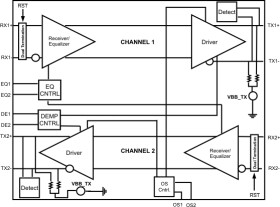Dual channel single-lane PCI Express Gen II redriver
Texas Instruments
 RSS
Sample
RSS
Sample
- Darmowa próbka
- MPN:
- SN65LVPE501
- Producent:
- TEXAS INSTRUMENTS
- Dodany do bazy:
- Ostatnio widziany:
The SN65LVPE501 is a dual channel, single lane PCIe redriver and signal conditioner supporting data rates of up to 5.0Gbps. The device complies with PCIe spec revision 2.1.
Programmable EQ, De-Emphasis and Amplitude Swing
The SN65LVPE501 is designed to minimize the signal degradation effects such as crosstalk and inter-symbol interference (ISI) that limits the interconnect distance between two devices. The input stage of each channel offers selectable equalization settings that can be programmed to match loss in the channel. The differential outputs provide selectable de-emphasis to compensate for the anticipated distortion PCIe signal will experience. Level of de-emphasis will depend on the length of interconnect and its characteristics. Both equalization and de-emphasis levels are controlled by the setting of signal control pins EQ1, EQ2 and DE1, DE2.
To provide additional control of signal integrity in extended backplane applications LVPE501 provides independent output amplitude control for each channel. See for setting details.
Device PowerOn Device initiates internal power-on reset after VCC has stabilized. External reset can also be applied at anytime by toggling RST pin. External reset is recommended after every device power-up. When RST is driven high, the device samples the state of ENRXD, if it is set H device enters Rx.Detect state where each channel will perform Rx.Detect function (as described in PCIe spec). If ENRXD is set L, automatic RX detect function is disabled and both channels are enabled with their termination set to ZDCRX.
Receiver Detection While ENRXD pin is H and device is not in sleep mode (RST is H), SN65LVPE501 performs RX.Detect on both channels indefinitely until remote termination is detected on both channels. Automatic Rx detection feature can be forced off by driving ENRXD low. In this state both channels input termination are set to ZDCRX.
Sleep (ShutDown) Mode This is low power state triggered by RST = L. In sleep mode receiver termination resistor for each of the two channels is switched to ZRX-HIGHIMP of >50 KΩ and transmitters are pulled to Hi-Z state. Device power is reduced to <1mW (TYP). To get device out of sleep mode RST is toggled L-H.
Electrical Idle Support A link is in an electrical idle state when the TX± voltage is held at a steady constant value like the common mode voltage. SN65LVPE501 detects an electrical idle state when RX± input voltage of the associated channel falls below VEIDTH min. After detection of an electrical idle state in a given channel the device asserts electrical idle state in its corresponding TX. When RX± voltage exceeds VEIDTH max, normal device operation is restored and output starts passing input signal. Electrical idle exit and entry time is specified at ≤6ns.
Electrical idle support is independent for each channel.
Power Save Features The device supports three power save modes as described below.
1. Sleep (ShutDown) Mode
This mode can be enabled from any state (Rx detect or active) by driving RST L. In this state both channels have their termination set to ZRX-HIGHIMP+ and outputs are at Hi-Z. Device power is 1mW (MAX)
2. Auto Low Power Mode
This mode is enabled when PS pin is tied H and device is in active mode. In this mode anytime Vindiffpp falls below selected VEIDTH for a and stays below VEIDTH for >1µs (TYP), the associated CH will enter auto low power (ALP) mode where power/CH will be reduced to <1/3rd of normal operating power/CH or about 70mW under typical voltage of 3.3V when ALP conditions are met for both channels. A CH will exit ALP mode whenever Vindiffpp exceeds max VEIDTH for that channel. Exit latency is 30ns max. To use this mode link latency will need to account for the ALP exit time for NFTS. ALP mode is handled by each channel independently based on its input differential signal level. This mode can be disabled by leaving PS as NC or tying PS to GND via 4.7kύ.
3. Cable Disconnect Mode
This mode is activated when RST is H, ENRXD = H, and no termination is detected by either channel. Device is in the Rx.Detect state whereby it is continuously performing Rx.Detect on both channels. In this state total power consumed by device is typically <3% of normal active power. Or <10mW (MAX).
Beacon Support With its broadband design, the SN65LVPE501 supports low frequency Beacon signal (as defined by PCIe 2.1 spec) used to indicate wake-up event to the system by a downstream device when in L2 power state. All requirements for a beacon signal as specified in PCI Express specification 2.1 must be met for device to pass beacon signals.
Devic Power
The SN65LVPE501 is designed to operate from a single 3.3V supply. Always practice proper supply sequencing procedure. Apply VCC first before any input control pin signals are applied to the device. Power-down sequence is in reverse order.
Elecena nie prowadzi sprzedaży elementów elektronicznych, ani w niej nie pośredniczy.
Produkt pochodzi z oferty sklepu Texas Instruments